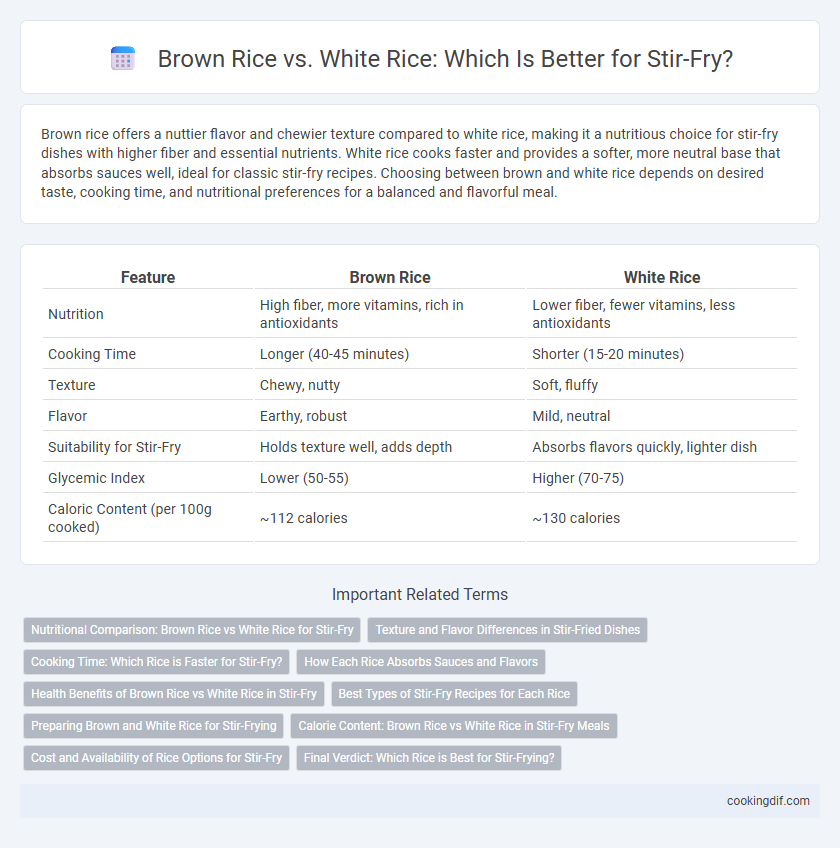Brown rice offers a nuttier flavor and chewier texture compared to white rice, making it a nutritious choice for stir-fry dishes with higher fiber and essential nutrients. White rice cooks faster and provides a softer, more neutral base that absorbs sauces well, ideal for classic stir-fry recipes. Choosing between brown and white rice depends on desired taste, cooking time, and nutritional preferences for a balanced and flavorful meal.
Table of Comparison
| Feature | Brown Rice | White Rice |
|---|---|---|
| Nutrition | High fiber, more vitamins, rich in antioxidants | Lower fiber, fewer vitamins, less antioxidants |
| Cooking Time | Longer (40-45 minutes) | Shorter (15-20 minutes) |
| Texture | Chewy, nutty | Soft, fluffy |
| Flavor | Earthy, robust | Mild, neutral |
| Suitability for Stir-Fry | Holds texture well, adds depth | Absorbs flavors quickly, lighter dish |
| Glycemic Index | Lower (50-55) | Higher (70-75) |
| Caloric Content (per 100g cooked) | ~112 calories | ~130 calories |
Nutritional Comparison: Brown Rice vs White Rice for Stir-Fry
Brown rice contains more fiber, vitamins, and minerals than white rice, making it a healthier option for stir-fry dishes. Its higher magnesium and antioxidant content supports better blood sugar control and digestion. White rice, though lower in nutrients, cooks faster and offers a softer texture preferred in many traditional stir-fry recipes.
Texture and Flavor Differences in Stir-Fried Dishes
Brown rice offers a chewier texture and nuttier flavor that enhances the complexity of stir-fried dishes, providing a heartier bite compared to white rice. White rice, with its softer, fluffier texture and milder taste, absorbs sauces more readily, creating a cohesive blend of flavors in stir-fry meals. Choosing between brown and white rice significantly impacts the overall mouthfeel and flavor profile of stir-fried dishes.
Cooking Time: Which Rice is Faster for Stir-Fry?
White rice cooks significantly faster than brown rice, typically taking about 15-20 minutes compared to brown rice's 40-45 minutes. This faster cooking time makes white rice a more convenient option for quick stir-fry meals. Brown rice requires longer soaking or pre-cooking to achieve the desired texture in stir-fry dishes.
How Each Rice Absorbs Sauces and Flavors
Brown rice has a chewier texture and retains bran layers, causing it to absorb sauces more slowly but offering a nutty flavor that complements stir-fry dishes. White rice, being more processed with the bran and germ removed, absorbs sauces quickly, allowing it to blend seamlessly with bold stir-fry flavors. The distinct absorption rates influence the overall taste and texture, with brown rice providing a heartier bite and white rice delivering a softer, more unified flavor profile.
Health Benefits of Brown Rice vs White Rice in Stir-Fry
Brown rice retains its bran and germ layers, providing higher fiber, vitamins, and minerals compared to white rice, which is stripped of these nutrients during processing. The increased fiber content in brown rice aids digestion and helps regulate blood sugar levels, making it a healthier option for stir-fry dishes. White rice, while quicker to cook and softer in texture, lacks the nutritional density that supports long-term health benefits found in brown rice.
Best Types of Stir-Fry Recipes for Each Rice
Brown rice's nutty flavor and chewy texture complement vegetable-heavy stir-fries, enhancing dishes like tofu and broccoli or mushroom and bell pepper combos. White rice's softer, fluffier grains absorb sauces well, making it ideal for chicken stir-fry with garlic or shrimp and snap peas that benefit from a milder rice base. Selecting jasmine brown rice boosts antioxidants and fiber in stir-fries, while classic white long-grain rice ensures traditional texture and quick cooking times for fast meals.
Preparing Brown and White Rice for Stir-Frying
Brown rice requires longer cooking time and extra water absorption compared to white rice, making it essential to pre-cook and cool before stir-frying to achieve optimal texture. White rice, preferably day-old, offers a drier consistency that prevents clumping and enhances stir-fry results. Soaking or rinsing both types removes excess starch, promoting separate, fluffy grains ideal for stir-fry dishes.
Calorie Content: Brown Rice vs White Rice in Stir-Fry Meals
Brown rice contains approximately 215 calories per cooked cup, while white rice has around 205 calories, making their calorie content quite similar for stir-fry dishes. The higher fiber content in brown rice contributes to better satiety and slower digestion, which can be beneficial for weight management compared to white rice. Choosing brown rice for stir-fry not only adds a nutty flavor and chewier texture but also provides additional nutrients like magnesium and antioxidants absent in white rice.
Cost and Availability of Rice Options for Stir-Fry
Brown rice, often pricier than white rice, tends to be less widely available in some grocery stores but offers a richer nutrient profile ideal for health-conscious consumers. White rice remains the more cost-effective and readily accessible choice, making it the preferred option for many stir-fry recipes due to its affordability and easy sourcing. The price difference and regional availability significantly influence the selection between brown and white rice for stir-fry dishes.
Final Verdict: Which Rice is Best for Stir-Frying?
Brown rice offers a nuttier flavor and higher fiber content, making it a healthier option for stir-frying, while white rice provides a softer texture and quicker cooking time that better absorbs sauces. For stir-fry dishes, white rice is typically preferred due to its light, fluffy grains that separate easily and complement the crisp vegetables and proteins. The best choice depends on whether texture or nutritional value is prioritized, but white rice often delivers the ideal balance for traditional stir-fry.
Brown rice vs White rice for stir-fry Infographic

 cookingdif.com
cookingdif.com